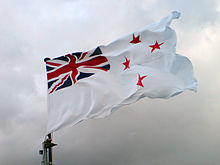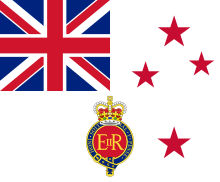New Zealand White Ensign
The New Zealand White Ensign (also known as the New Zealand Naval Ensign or the Royal New Zealand Navy Ensign) is a naval ensign used by ships of the Royal New Zealand Navy (RNZN) from 1968. Based on the Royal Navy's White Ensign, it features the Southern Cross from the New Zealand national flag in place of the Saint George's Cross. One of the earliest flags associated with the country, that used by the United Tribes of New Zealand, was a white ensign. This was replaced by the Union Flag when New Zealand became a British colony. A blue ensign with the Southern Cross was introduced for ships of the colonial government in 1867 and this soon became a de facto national flag. Ships in New Zealand naval service wore the Royal Navy's White Ensign until 1968 when the distinct New Zealand White Ensign was introduced. The ensign was implemented out of a desire to distinguish New Zealand vessels from those of the Royal Navy and this decision is regarded as an important step in the development of the RNZN.
 | |
| Use | Naval ensign |
|---|---|
| Adopted | New Zealand White Ensign Regulations 1968 |
| Design | A Royal Navy White Ensign defaced with a Southern Cross in lieu of the St George Cross. |
The New Zealand White Ensign is flown from commissioned RNZN vessels and shore establishments during daylight hours. It is also flown from the top of the Auckland Harbour Bridge to mark the anniversary of the founding of the RNZN. The right to fly the ensign was granted to flag officers of the Royal New Zealand Yacht Squadron upon their centenary in 1971 and it may also be used by New Zealand examination vessels.
History

A version of a white ensign was adopted as the flag of the United Tribes of New Zealand, a confederation of Māori tribes on the North Island, by a vote in 1834 and approved by the British resident James Busby. This flag had a red Saint George's Cross and the upper canton was blue with a red cross and four eight-pointed stars in each quadrant.[1] After the Treaty of Waitangi in 1840 the British Union Flag was established as the flag of the colony and New Zealand ships followed the system of British ensigns.[2] A design based on the British Blue Ensign was introduced for New Zealand government vessels in 1867 and unintentionally became the de facto national flag.[3] When the official adoption of a national flag was discussed in the New Zealand House of Representatives in 1900 William Campbell Walker claimed that the White Ensign had not been considered as the basis of a new national flag in 1867 due to opposition from the Royal Navy, which used the ensign to identify its vessels.[4] The Blue Ensign was adopted by New Zealand officially as its national flag in 1902.[3]

Unofficial New Zealand naval units that fought in the New Zealand Wars wore only a union flag. The New Zealand Naval Forces were established in 1913 but only as a division of the Royal Navy; its ships therefore wore the usual Royal Navy White Ensign. In 1921 the New Zealand vessels were granted permission to fly the national flag as a jack but, as jacks are not worn at sea, this meant ships in battle were not readily identifiable as belonging to New Zealand.[5] The Royal New Zealand Navy (RNZN) was established as a separate force in 1941 but, due to the ongoing Second World War, there was apparently no discussion about granting it a unique ensign. The RNZN continued to use the British White Ensign including on active service during the Korean War and Malayan Emergency.[5]
In 1967 the Royal Australian Navy adopted its own unique white ensign in part because it was fighting in the Vietnam War, in which the British were not involved, effectively under a British flag.[6] This seems to have inspired a similar change in the RNZN and in 1967 Mr E.W. Jones of the Hydrographic Branch was appointed to design a white ensign for the New Zealand fleet.[5] This was approved by Elizabeth II and adopted by the New Zealand White Ensign Regulations 1968, an Order in Council made by Governor-General Arthur Porritt on 10 June 1968.[7][5] The adoption of a unique white ensign has been noted as an important step in the development of the RNZN.[5]
Description

The New Zealand White Ensign, as defined in the 1968 regulations, is identical to the national flag except that the field is white instead of blue and the white border to the stars is replaced with red.[7] In common with the national flag the White Ensign is 1:2 in ratio and has the British Union flag in the canton. The colours used in the ensign are white (Pantone SAFE), red (Pantone 186C) and blue (Pantone 280C). The four stars of the Southern Cross are depicted with five points.[8]
Use

The 1968 regulations allow the flag to be flown by ships of the New Zealand Naval Forces and at navy establishments.[7] In current RNZN practice the White Ensign is flown only during daylight hours but in times of war it is flown continuously.[9] It had been flown from the top of Auckland Harbour Bridge annually on 1 October since 2016 to mark the day the RNZN was founded.[10] The RNZN has also been granted a Queen's colour, which serves a similar purpose to the colours of army regiments. The colour is a variation of the White Ensign with more square proportions and the addition of a device showing the crowned royal cypher of Elizabeth II encircled by the emblem and motto of the Order of the Garter.[5]
The White Ensign may also be used by New Zealand examination vessels, though these would typically wear the Examination Service flag or the Blue Ensign.[11] In 1971 flag officers of the Royal New Zealand Yacht Squadron were granted the right to wear the White Ensign in recognition of the centenary of the organisarion.[5] The New Zealand merchant ensign is identical to the White Ensign but with the colours of the field and stars transposed.[12]
References
- "United Tribes flag - Flags of New Zealand". New Zealand History. New Zealand Government.
- "Union Jack - Flags of New Zealand". New Zealand History. New Zealand Government.
- "The NZ flag - Flags of New Zealand". New Zealand History. New Zealand Government. Retrieved 31 July 2020.
- Parliament, New Zealand (1900). Parliamentary Debates: House of Representatives. p. 566.
- "The White Ensign". Torpedo Bay Navy Museum. National Museum of the Royal New Zealand Navy. 19 October 2015. Retrieved 31 July 2020.
- "Australian White Ensign". Royal Australian Navy. Retrieved 31 July 2020.
- "New Zealand White Ensign Regulations 1968 (SR 1968/93) (as at 14 June 1968) – New Zealand Legislation". New Zealand Legislation. Parliamentary Counsel Office. Retrieved 31 July 2020.
- "Description and dimensions". Ministry for Culture and Heritage. Retrieved 31 July 2020.
- "Other flags". Ministry for Culture and Heritage. Retrieved 31 July 2020.
- Collins, Hugh (30 September 2016). "Royal New Zealand Navy White Ensign flying above Auckland Harbour Bridge". Stuff. Retrieved 1 August 2020.
- Sailing Directions (planning Guide).: Pacific Ocean and Southeast Asia. National Imagery and Mapping Agency. 2001. p. 148.
- Barraclough, E. M. C.; Crampton, William G. (1978). Flags of the World. F. Warne. p. 211.